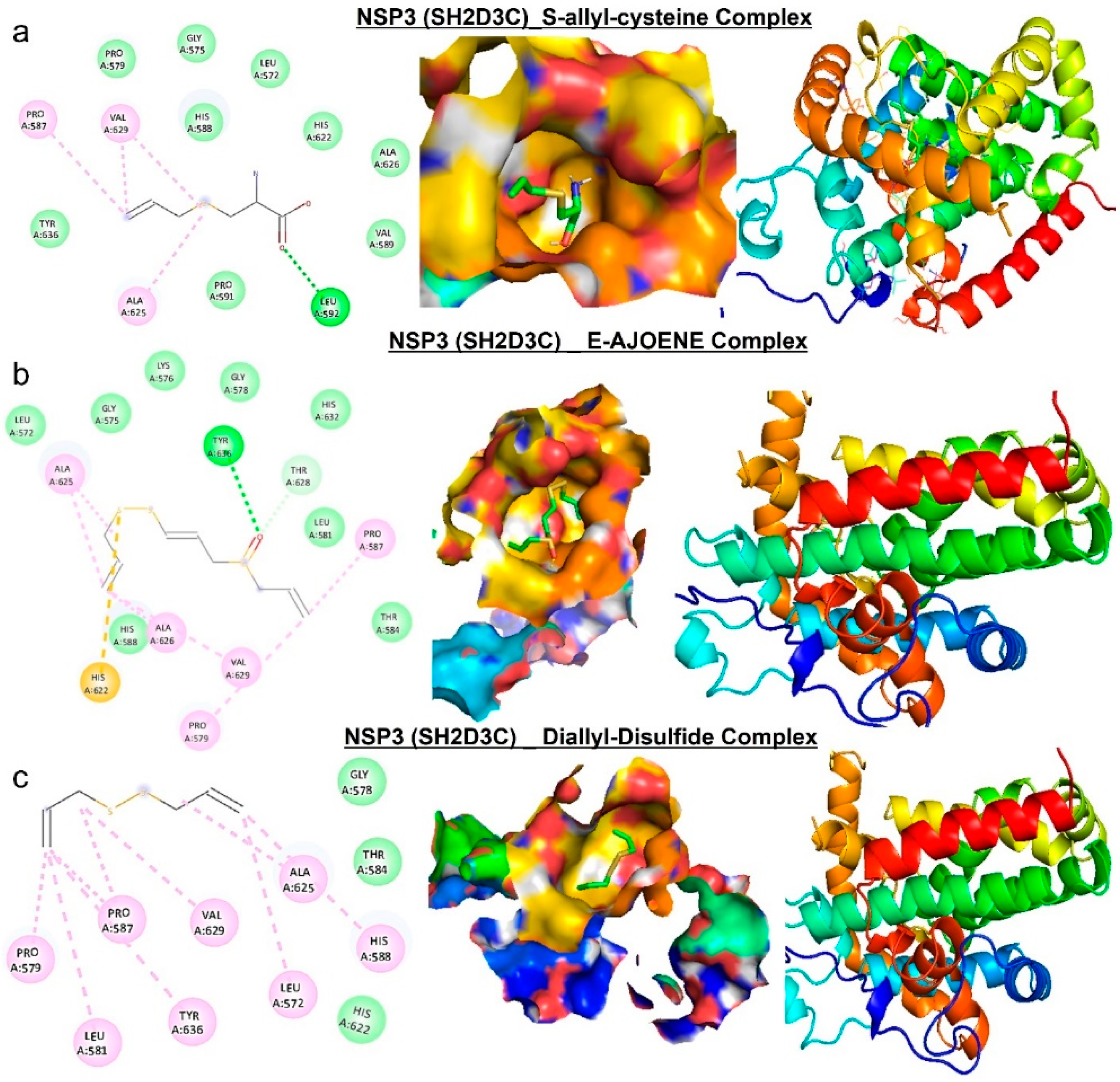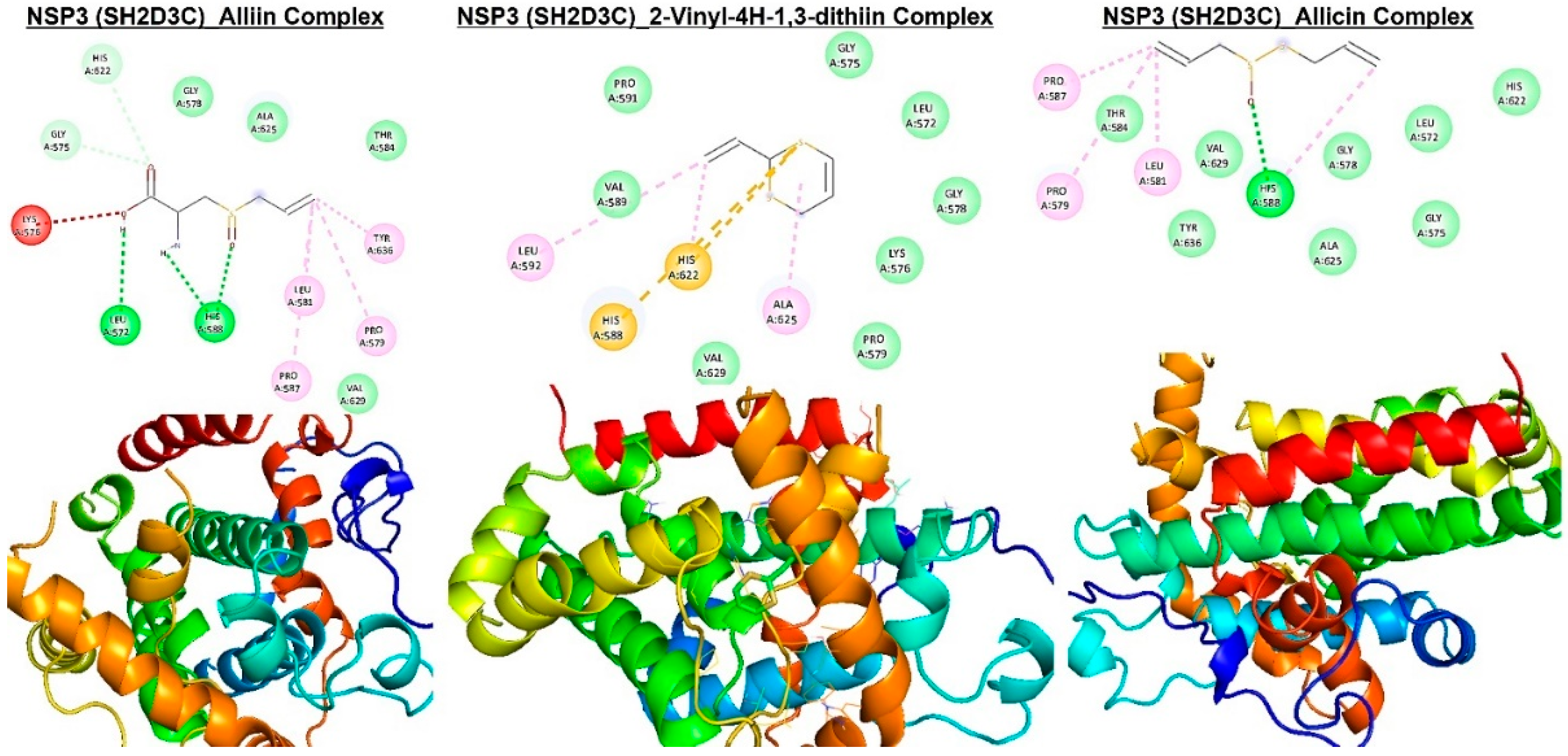Correction: Yeh et al. Identification of NSP3 (SH2D3C) as a Prognostic Biomarker of Tumor Progression and Immune Evasion for Lung Cancer and Evaluation of Organosulfur Compounds from Allium sativum L. as Therapeutic Candidates. Biomedicines 2021, 9, 1582
Error in Figures/Table


| S-allyl-cysteine | E-AJOENE | Alliin | Diallyl-Disulfide | Allicin | 2-Vinyl-4H-1,3-dithiin | |
|---|---|---|---|---|---|---|
| ΔG (Kcal/mol) | −4.40 | −4.40 | −6.70 −4.70 | −3.50 | −3.90 | −4.00 |
| Hydrophobic contact | PRO587 (3.85 Ӑ) HIS622A (3.78 Ӑ) ILE131 (3.62 Ӑ) PHE132 (3.61 Ӑ) PHE156 (3.70 Ӑ) | PRO579 (3.50), LEU581 (3.52), THR584 (3.56), PRO587 (3.79), ALA625 (3.62) | Pro579 (3.99), leu581 (3.89), thr584 (3.78), pro587 (3.94) | Leu572 (3.72), pro579 (3.90), leu581 (3.79), thr584 (3.67), pro587 (3.79), his588 (3.75) | Leu572 (3.87), pro579 (3.92), leu581 (3.77), thr584 (3.89), pro587 (3.51), his588 (3.74) | His588 (3.75), his622 (3.76), ala625 (3.53) |
| Conventional H-bond | LEU592 (2.21) | Thr636 (2.61) Thr628 (3.64) | His622, gly575, leu572, his588 | His588 | ||
| Pi-sulfur | his622 | His588, his622 | ||||
| alkyl interaction | VAL626, PRO587, ALA625 | Ala625, ala626, val629, pro579, pro587 | Tyr636, leu581, pro587, pro579 | Pro579, pro587, val629, ala625, leu581, tyr636, leu572, his588 | Pro587, pro579, leu581 | Leu592, ala625 |
| Van der waal forces | Pro579, Gly575, His588, Leu572, His622, Ala626, Val589, Pro591, Tyr636 | Leu572, Gly585, Lys576, Gly578, His632, Leu581, Thr584, His 588 | Val629, Thr584, Ala625, Gly578 | His622, Gly578 | Thr584, Tyr636, Val629, Ala626, Gly578, Gly575,Leu572, His622 | Pro591, Val589, Val629, Pro579, Lys576, Gly578, Leu572, Gly575 |
Text Correction
References
References
- Yeh, Y.-C.; Lawal, B.; Hsiao, M.; Huang, T.-H.; Huang, C.-Y.F. Identification of NSP3 (SH2D3C) as a Prognostic Biomarker of Tumor Progression and Immune Evasion for Lung Cancer and Evaluation of Organosulfur Compounds from Allium sativum L. as Therapeutic Candidates. Biomedicines 2021, 9, 1582. [Google Scholar] [CrossRef] [PubMed]
- Dodelet, V.C.; Pazzagli, C.; Zisch, A.H.; Hauser, C.A.; Pasquale, E.B. A novel signaling intermediate, SHEP1, directly couples Eph receptors to R-Ras and Rap1A. J. Biol. Chem. 1999, 274, 31941–31946. [Google Scholar] [CrossRef]
- Sakakibara, A.; Ohba, Y.; Kurokawa, K.; Matsuda, M.; Hattori, S. Novel function of Chat in controlling cell adhesion via Cas-Crk-C3G-pathway-mediated Rap1 activation. J. Cell Sci. 2002, 115, 4915–4924. [Google Scholar] [CrossRef] [PubMed]
- Wang, L.; Vervoort, V.; Wallez, Y.; Coré, N.; Cremer, H.; Pasquale, E.B. The SRC homology 2 domain protein Shep1 plays an important role in the penetration of olfactory sensory axons into the forebrain. J. Neurosci. 2010, 30, 13201–13210. [Google Scholar] [CrossRef]
Disclaimer/Publisher’s Note: The statements, opinions and data contained in all publications are solely those of the individual author(s) and contributor(s) and not of MDPI and/or the editor(s). MDPI and/or the editor(s) disclaim responsibility for any injury to people or property resulting from any ideas, methods, instructions or products referred to in the content. |
© 2025 by the authors. Licensee MDPI, Basel, Switzerland. This article is an open access article distributed under the terms and conditions of the Creative Commons Attribution (CC BY) license (https://creativecommons.org/licenses/by/4.0/).
Share and Cite
Yeh, Y.-C.; Lawal, B.; Hsiao, M.; Huang, T.-H.; Huang, C.-Y.F. Correction: Yeh et al. Identification of NSP3 (SH2D3C) as a Prognostic Biomarker of Tumor Progression and Immune Evasion for Lung Cancer and Evaluation of Organosulfur Compounds from Allium sativum L. as Therapeutic Candidates. Biomedicines 2021, 9, 1582. Biomedicines 2025, 13, 188. https://doi.org/10.3390/biomedicines13010188
Yeh Y-C, Lawal B, Hsiao M, Huang T-H, Huang C-YF. Correction: Yeh et al. Identification of NSP3 (SH2D3C) as a Prognostic Biomarker of Tumor Progression and Immune Evasion for Lung Cancer and Evaluation of Organosulfur Compounds from Allium sativum L. as Therapeutic Candidates. Biomedicines 2021, 9, 1582. Biomedicines. 2025; 13(1):188. https://doi.org/10.3390/biomedicines13010188
Chicago/Turabian StyleYeh, Yuan-Chieh, Bashir Lawal, Michael Hsiao, Tse-Hung Huang, and Chi-Ying F. Huang. 2025. "Correction: Yeh et al. Identification of NSP3 (SH2D3C) as a Prognostic Biomarker of Tumor Progression and Immune Evasion for Lung Cancer and Evaluation of Organosulfur Compounds from Allium sativum L. as Therapeutic Candidates. Biomedicines 2021, 9, 1582" Biomedicines 13, no. 1: 188. https://doi.org/10.3390/biomedicines13010188
APA StyleYeh, Y.-C., Lawal, B., Hsiao, M., Huang, T.-H., & Huang, C.-Y. F. (2025). Correction: Yeh et al. Identification of NSP3 (SH2D3C) as a Prognostic Biomarker of Tumor Progression and Immune Evasion for Lung Cancer and Evaluation of Organosulfur Compounds from Allium sativum L. as Therapeutic Candidates. Biomedicines 2021, 9, 1582. Biomedicines, 13(1), 188. https://doi.org/10.3390/biomedicines13010188







